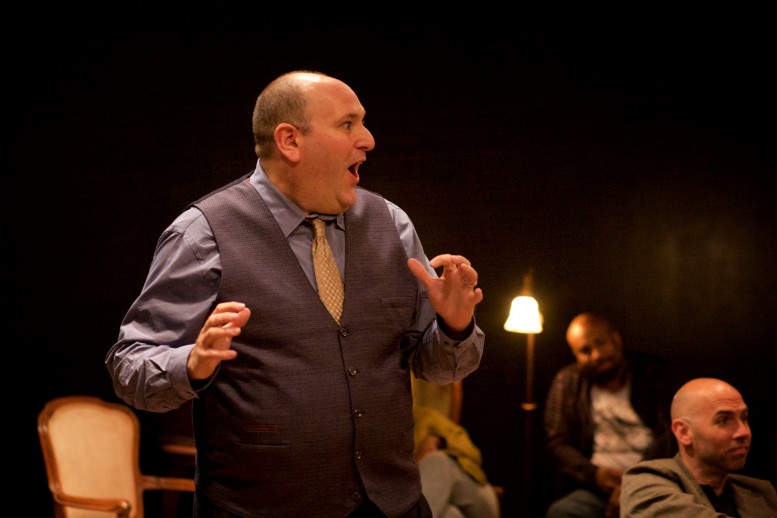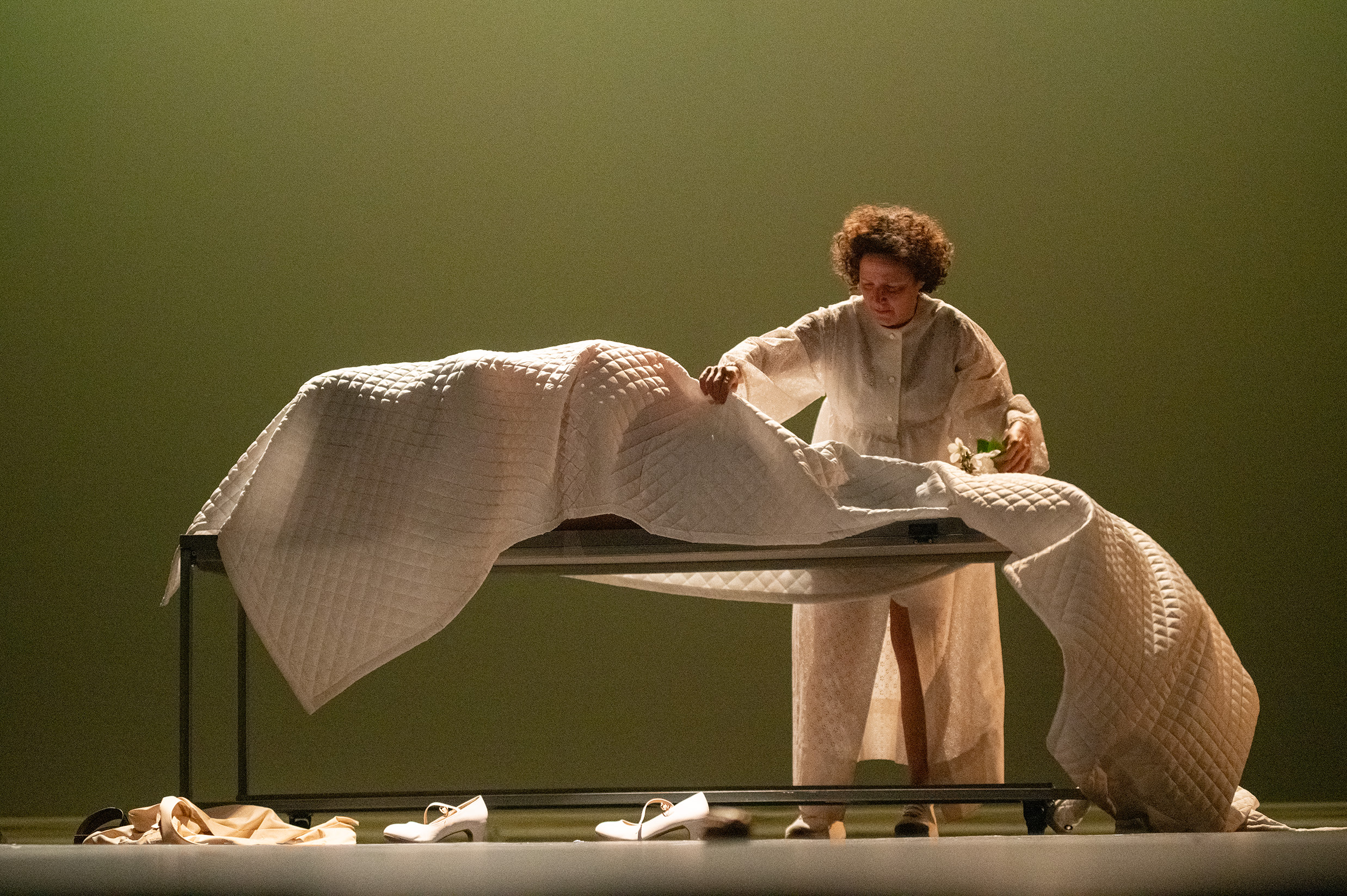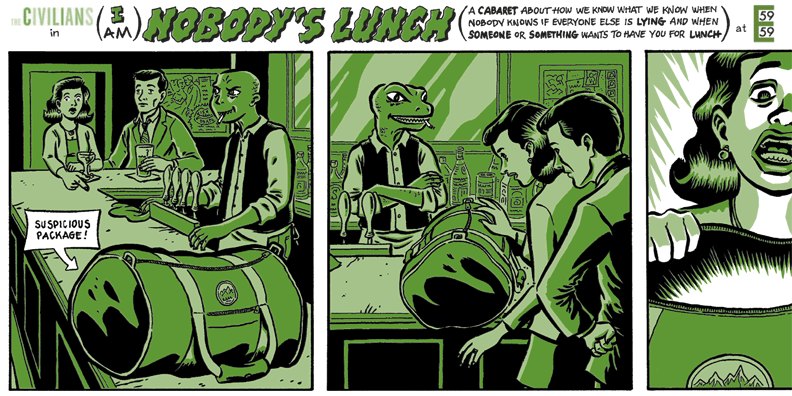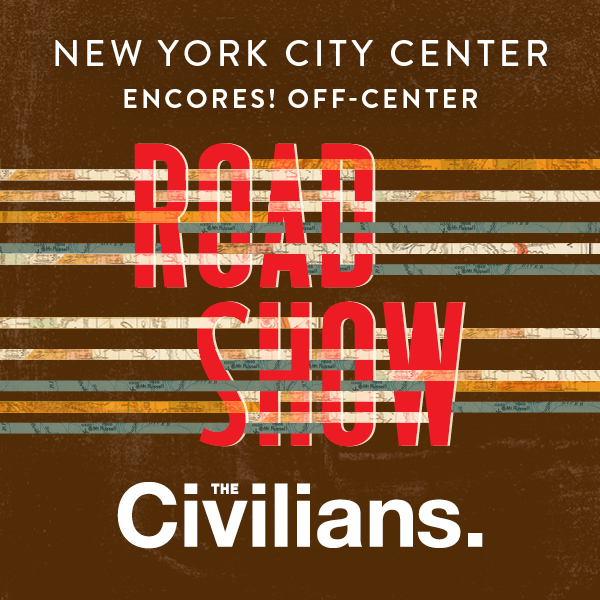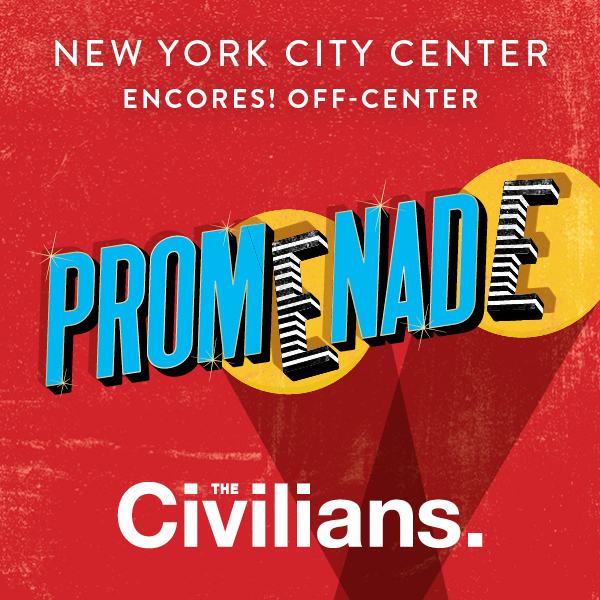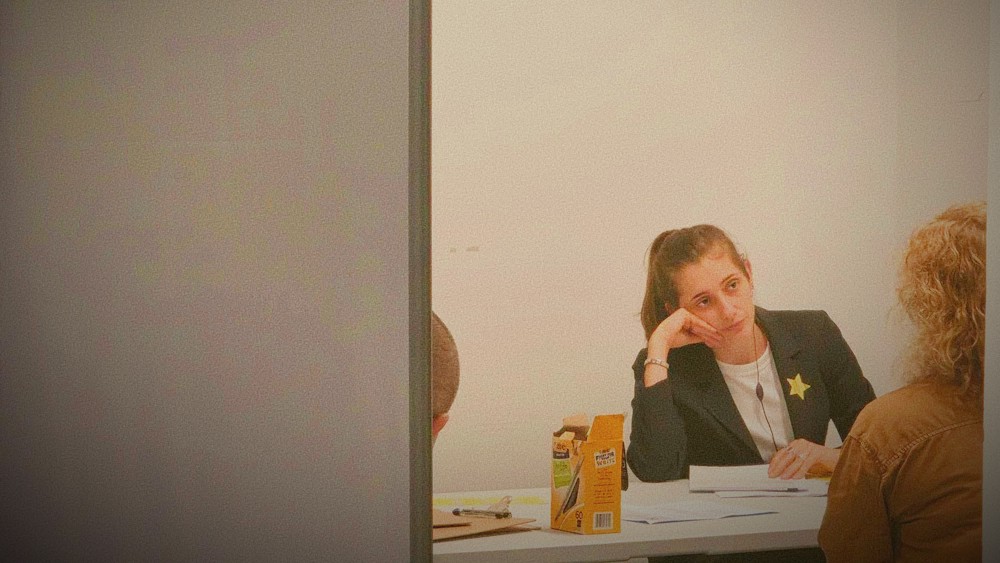The Welders is a unique Washington D.C.-based theater company made up of five playwrights and one executive/creative director acting as stewards of the company until they’ve produced all five playwrights. Then, as was the case with 13P or Orbiter3, they’ll move on with their lives. But unlike these other two companies, the Welders will endure as a company, with the current group bestowing the mantle to a new group of theater artists seeking self-production.
This month, the Welders’ five playwright cycle comes to a close with Gwydion Suilebhan’s “Transmission,” a highly personal and ritualistic immersive play about how we share information.
Extended Play’s James Carter caught up with the playwright, who presently also wears the hats of Welders’ artistic director and the play’s lead actor, just days before the play’s opening.
“Transmission” runs April 30 to May 28 at the Atlas Performing Arts Center in Washington D.C.
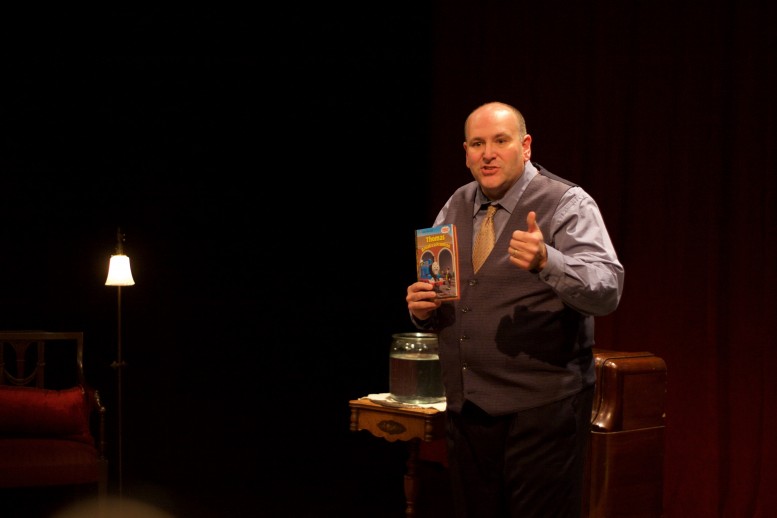
JAMES CARTER: What is “Transmission,” and what inspired you to write it?
GWYDION SUILEBHAN: “Transmission is an immersive, participatory sermon on the viral evolution of culture from the radio age to the present. Audiences of 20 — no more than 20 — sit in over-stuffed arm chairs and wing-backed chairs and beautiful couches from the 1930’s in a sort of club-style living room setting surrounded by 1930’s radios, and then I perform a sermon that comes part from me and part from the radios, so that my voice is coming from other places, and other things are coming from other places. Clips of old Superman radio dramas and baseball broadcasts and music. Coltrane. “Don’t Sit Under the Apple Tree.” You know, some ’30s music. It’s kind of a sonic mash up experience. And then act two is a facilitated discussion-experience of what happens in act one. It’s a different performer who runs that. She’s actually a dramaturg more than a performer. Although, she is also a performer, and she is also performing. So, basically, she greets people and seats them and gives them candy and helps them to their seats and asks them to write a little something on a card that I don’t want to spoil by saying more about it. And then she goes, and I do my thing. I do this huge, fifty-minute sermon. Then, blackout, and I leave, and she’s back. She walks people through an experience to sort of process and digest the fifty minutes. And then I come back for the last two and a half minutes — not even two and a half — for this sort of ritual that we’ve been guiding toward. What’s amazing is in the two performances we’ve given now – you know, it’s very participatory, and I wasn’t sure — not everyone likes that. But, so far, everyone or almost everyone has participated in the ritual, which is kind of amazing. Because I think it’s a profound moment.
And so the answer to your second question is even weirder. My son inspired me to write this. And I didn’t realize this until two-thirds of the way through the rehearsal process. When my son was two months old, I was asked to give a real sermon at a congregation in St. Louis. The Ethical Cultural Society of St. Louis. And I was invited to speak about whatever I wanted to speak about. And what I spoke about was the difficulty of choosing books for my son to read. How to know what stories were going to be good for his brain and which ones weren’t. You know, that’s a huge responsibility that we take a little lightly, I think. Like, everyone wants good books. Surround your kid with books, but it’s very hard to be very discerning. And really the idea grew out of that. Because I began to think how stories — and, more broadly, culture in general — how culture makes us more than we make culture. And how problematic that is. How, in the Information Age, we are so besieged by stories, and how we don’t have effective filters and settings in our brains to protect us from that onslaught. So, really, the whole piece came from the love of my son and wanting to protect him — or not even protect him, but give him the tools to handle the onslaught of narrative in which we all live in the 21st century.
JAMES: The out of control memes. Is that what you’re talking about?
GWYDION: Yeah.
JAMES: “Memes.” What are they, and should we be terrified of them?
GWYDION: So, I think everyone understands memes wrong. The word meme, itself, has been co-opted and sort of sanitized by popular culture. A meme is really just a unit of thought. So if a human being, or living matter, is made of genes, ideas are made of memes. A meme is functionally defined or was defined by Richard Dawkins, the man who invented the term — jerk though he may be — as a unit of information. And culture operates from a meme’s point of view in a very different way than we realize. A meme wants to be replicated. A meme gets into our minds and establishes a reservoir in our memories and then forces our communication centers to infect other people with the same meme. That’s what a meme wants to do. Memes writ large are — Superman is a meme. Episcopalianism is a meme. It’s a big one. A jingle is a meme. Pick any philosophy, it’s a meme. So these things want to survive and be replicated. So they try to live, in the same way that our genes want to survive and be replicated and passed on. Memes as they currently appear in pop culture — some gif with some words over it, or some image with some words over it — is not the same thing. It’s like a mere shadow of what a meme really is.
JAMES: And should we be terrified of them?
GWYDION: I don’t think we need to be terrified, really. I think we are all at sea in memes. I think that – I don’t want to say too much and give away a key line in the play. We are too willing to accept as true and to pass on information. We think we’re being skeptical sometimes and we are not. I just read a great article yesterday about a story that — the whole reason Popeye ate spinach was because spinach had lots of iron, and thus, the cartoonist spinach would make us strong. But then we found out later that the German chemist in the 1890’s who measured the amount of iron in spinach actually misplaced a decimal point, and it had a tenth of the amount that he actually thought. So that isn’t really true. And so there’s that famous debunking of Popeye and spinach. This guy’s decimal point. Except. It’s all wrong. There was never a chemist in the 1890’s who misplaced a decimal point. He just calculated iron the way they did in 1890. The way they do it now, it’s much more accurate. And it happens to be a tenth of what he thought it was. But there was no misplacing of the decimal point. And, Popeye never claimed that he was eating spinach for the iron. In fact, the cartoon itself said, “We’re eating spinach for the vitamin A. Vitamin A makes you strong.” Right? So the whole thing is lies built on lies built on lies. The debunking of the story is itself a lie. And we’re really happy to just repeat everything all the time. We live in this constant stream of repeats and retweets and shares without any deepening of the dialogue, and we need, in this information age, to have more savvy filters about how we pass along information. And that’s what this sermon’s all about — the desperate need to do that. And it’s so easy to point the finger at others and say, “You need to do it,” or “You need to do it.” It is incredibly hard to do it to yourself. To really resist the impulse. To imagine letting go of things you think are true, especially the more strongly you feel about those things. It’s just friggin’ hard. But it’s more vital than ever because the information’s kind of taking over. And all of our brains have become domesticated. We are occupied territory.
JAMES: You’re calling this a “sermon.”
GWYDION: Yeah. At first, I called it a “performance essay.” And then I called it a “jazz essay.” And then I called it a poem. I think I’ve settled on “performance sermon” or just “sermon.” Even though all these words are sort of fraught and loaded, and I don’t know if any of them is entirely right. But, yeah, it’s effectively a sermon because I do a ritual at the end. It’s hard. I mean, I really do feel like a priest. The thing about a priest is a priest can tell you what the rules are and then has to live them in front of you even more extremely than you have to live them. That’s why a minister has to hold him or herself to a higher standard. I have to do the thing in front of people every night that I’m calling on audience members to do, which means that final ritual is pretty intense for me and not an easy thing to accomplish night after night.
JAMES: How do you think the ritual will change? What do you imagine it will become?
GWYDION: It’s been getting harder because my director has been challenging me to make it harder. To really acknowledge how hard it is, what I’m doing. And so that’s good. I think it’s also hard because I’m a very infrequent actor. While I’m generally free-with-my-emotions kind of person — I wear my heart right on my sleeve — actors are trained to access that stuff on command in a way that I, you know, I’ve acted enough to know that I have to do it. It’s not as easy for me. So, to go down into that depth every night at the end of act one and do the thing I have to do, I suspect it’s going to be hard. But it really must be different every night because if I’m repeating the same thing over and over again, night after night after night, then I am not living up to what the play demands of me in about six different ways. The play is all about repetition with variation. That’s why it’s steeped in jazz and evolution. That’s what evolution is: it’s repetition with variation. Genes replicate themselves with tiny errors, and those errors become, most of them fail, but some of them become the new generation. So, that’s life. Repetition with variation. So I have to repeat the play every night, but do it a little bit different every night, too.
JAMES: I find it interesting that you chose the construct of a sermon, and then you are doing a ritual at the end of the piece, which frames it in almost a religious setting. I know you’re atheist. Why did you choose this construct?
GWYDION: I’m an atheist. I guess I’ve sort of lost touch with that term, but I don’t believe in God. When people ask me who really want to know the answer, and who aren’t trying to start a fight, my answer is this: My brain is wired in such a way that it cannot believe in God. That’s what I think. I’ve tried and failed. I can’t do it. My brain doesn’t have that wiring. I believe that it is our brains that allow us to have, and the wiring in our brains, in combination with the experiences we have and the stories we’re told, that manufacture a belief in a higher power out of the raw material of our wiring. I don’t have it. And I don’t think I ever will. And I’m fine with that, actually. I wasn’t fine with that earlier in my life, but I am fine with that now.
However, I have always been manifestly spiritual in a certain way and really, really interested in occupying the roll of someone who helps people create meaning in their lives. I perform wedding ceremonies. I’ve spoken at several funerals and unveilings and that sort of thing. I’ve always said if I could have any job in the world, it would be atheist Catholic priest. Give me a gorgeous cathedral to work in, Once a week I will write a blazingly good sermon and deliver it, and I will minster to people in their times of need. I just can’t do the believing in God part. Or the talking about God part. But all the other stuff — caring for people, writing a talk and giving it once a week, working in these glorious buildings to help people create meaning — I could totally do that. But see, just the fact that I say, “create meaning,” is what makes me ineligible for the job. Because Catholics believe God is what gives their lives meaning, and I just don’t. But everything else about it is just so gorgeous. And I visit every cathedral I can in every major European city I visit because I am so moved. So, it’s not that strange for me to put myself in this role. When you’ve done seven, eight, nine, I can’t remember, wedding ceremonies for people, and I feel really at home when I’m doing them. I feel really lucky to be there. And like I’ve got a lot of love to give and poetry to bring to the occasions. So this is just part of that.
I was meeting with the costume designer early in the production process – and really this was more of devising process than it was just of a thing I wrote – I mean, the first person I showed the first half draft of this thing to was the sound designer. I gave him seven pages of stuff of which, maybe, two made it into the final draft. Said, “Here’s what I want to do.” And he was like, “I’m on board.” I know how long this’ll take you to write. I’m your sound designer and composer because I can see where this is going. He let me talk for two hours, and he made it better. So, it was a kind of devising-ish process. So, I talked to the costume designer, and she said, “Who are you really? What role are you playing? How should I dress you? What do you want to come across as? It’s not formal, what you’re doing, but it’s also not casual. It’s really meaningful.” And I said, “You know who I want to be? I want to be like a modern version of Mister Rogers. I want to be comforting but a little bit dressed up. Because I’m a minister. Find pictures of ministers. Not priests but ministers. How they dress when they’re not in their collar.” I showed her a picture of the minister on “Call the Midwife” when he wasn’t wearing his collar, and I was like, “Look, that guy. Just like that.” So we designed a costumed that helped create that feeling. It feels natural to me. This is like no sermon you’ve ever been to. There is not a lot of exhortation. I mean, there are moments of fire and brimstone, but there’s also moments of levity and seriously bizarre things coming out of me. You make a turn from algebra to the influenza epidemic of 1918 within sentences. It’s some hard shit. But it’s great. I love it.
JAMES: Yeah, I think, knowing you, I know you love and are supportive of community. It seems that is what you’re trying to create here is create a sermon that speaks to a small gathering or a community, and you bring them together at the end with this ritual that’s going to bind them. Rituals bind people, right? So you’re entering into a sacrament with these other people, and it seems to me, that’s very much who you are.
GWYDION: That’s exactly right. I must say four or five times in the play in key moments, and I repeated it in the playbill, which you get after you leave because it’s the meme and I don’t want people to take it lightly. We are all in this together. That’s the rallying cry in some ways. We are all in this together. I really work hard to get everyone in the room, to get them breathing together, to get them taking each other in, to get them listening to each other. And then, even in all of act two, to get them talking to one another and sharing and dialoguing. Then, we do this ritual and we go back out into the world, changed. That’s why this is what it is. And that’s why it’s only 20 people. I could have written something for an audience of 80 or whatever, but that’s not what this wants to be. It’s really just not.
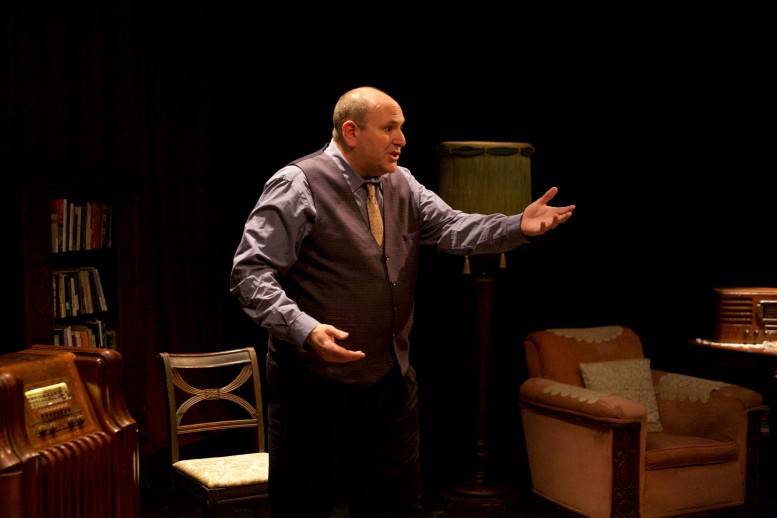
JAMES: This is immersive. You’re creating a space. You’re bringing in special seats for the audience. And it’s participatory.
GWYDION: Immersive. There’s no distinction between set and seating. There’s 20 armchairs, and a little dining room chair for me. And one couch. Maybe 17 armchairs for a total of 20 seats all clustered around tables, and on every table, there’s an antique radio and a dish of candy and some books. And it’s all on this massive, massive antique rug. It’s a black box, and the bones of it shine through. There’s some soft goods hanging, but it’s mostly an unfinished space because I didn’t want to fool anyone into this, “Oh, you’re in an artificial world now.” No, you have to help create it with me. You finish the space with your mind. That’s the immersive nature. I’m literally sitting next to you in the space when I’m talking. And then the participatory nature is really from the very beginning. You’re interacting with the host, and then there’s several moments in which I ask people to raise their hands and to stand, the way a minster would ask you, “Will you all please rise? You may now be seated.” There’s questions back and forth. And I’m literally walking up to people and delivering lines right to them. So it’s not for your grandma, unless your grandma’s pretty cool. It’s not for the theater-goer who wants to sit back and take a story in in the dark. Although, a lot of this is in the dark because, as I say in the play, “In the dark, any image I create with my words, with my voice, you create, too, with your mind. So, in the dark, we collaborate.” So there’s a lot of the play that happens in the dark. But it’s not really sit back and be passive. You are fully going to work for at least half of what you’re signing up for.
JAMES: What do you think about the current state and the future state of participatory work? It’s been around for a long time. It’s not a new form. But, of course, it’s made a huge surge in the last seven years. What do you imagine it being?
GWYDION: I consider it the future of our artform. We as theater-makers — when I say “we” I mean all the kinds who make musicals and straight plays and us who make funky things — have got to continue to distinguish ourselves from television and movies. We have got to distance ourselves from the paradigm of “I sit back and consume.” And what I’m consuming is something that a million people also consume. We have got to start creating and thinking about the work we do as creating experiences. And and experience is more than just sitting in the dark, watching actors pretend to be other people. That’s one kind of experience. But experiences are bigger than that. They’re everything from “Sleep No More” to Dog and Pony’s “Beertown (Takes America)” to Cornerstone’s “Uban Rez.” A play needs to become something to do, rather than something to watch. The more that we can get people saying, “I went and did a play,” rather than, “I went and watched a play last night,” I think the better off we will be.
JAMES: But do you think that’s a niche? Will there still be people who want to sit in the dark and watch actors pretend to be other people? This is the reason I’m asking: Some people don’t like to participate. But people like to go to the theater.
GWYDION: Yeah. I don’t think we are doing away with sitting in a seat and watching actors pretend to be other people. That’s not going to go away tomorrow. There’s no revolution happening where it’s all about to change. And it’s also several thousand years old, so you don’t get rid of something that’s several thousand years old overnight. But I think it’s largely getting subsumed by electronic versions of the same thing. And I don’t think it’s a terrible loss. I think it’s just what is. So, I think, we may have another thousand years of it. If I could prognosticate, which is a fool’s errand, but if I would, I would say that in some number of centuries from now, theater will be a thing we all do not a thing we watch.
JAMES: Isn’t that Greek?
GWYDION: In a way, yes.
JAMES: In a way. And, in a way, what you’re doing is slightly Greek.
GWYDION: Uh, huh.
JAMES: Because there’s ritual. I’m wondering — does it all come back to the beginning? And/or is this your evolution? Is this the change? The DNA has shifted and there are little pieces of the Greeks still in what you’re doing or what “Sleep No More” is doing and then there is a variation on that memetic makeup?
GWYDION: I think that’s absolutely true, what you just said. I don’t think I’m doing anything particularly new. Maybe what I’m doing is — it’s rare still in D.C. D.C. is very much an orator’s town, right? You’ve got Congress. That’s all it does is give speeches. That’s all the President does. That’s all politicians do. And so our theater, in our biggest institutions, really resembles that. Theater is a broadcast mechanism at most of our big theaters here. And that’s because that’s what a lot of people want. It’s a very apollonian city. It’s a very, sort of, top-down-city. So it’s unique in the culture here. Although, we do have Dog and Pony and some other rising companies that are doing some different things. You know, we ain’t New York. We ain’t even Pittsburgh on this front. I mean, Dog and Pony’s pretty great. I can say their name six other times so that people know it. Dog and Pony. Dog and Pony. Dog and Pony. Dog and Pony. Dog and Pony. Dog and Pony.
JAMES: Yeah. We need to get them on Extended Play.
GWYDION: Yeah. So, I’m breaking ground here in D.C. You know, I’m interested — the reviewers come on Sunday. It’s the big publications and the big blogs. And I have no idea how they’re going to review this because I don’t even know if they have the vocabulary to review it properly. I don’t want to underestimate them. These are some smart critics, actually, who are coming. But, when you don’t see a lot of this work, how do you know how to judge it? How do you have any context for it?
JAMES: I think that’s a big question that has been out there recently with regards to immersive, especially immersive work that is multi-pronged. You’re taking it pretty much on a linear journey and there’s maybe some deviation, but it’s not like you’re sending the audience into a 20 room house and just having them experience the things they experience. And I think that’s the thing that’s really challenging for critics right now, is to find the language, even the headspace. I recently read a review of another immersive piece that has those multi-prongs, and the critic went twice, hoping to get a different experience, and ended up having basically the same experience the second time around. And I was, like, “Haha!” What are you going to do? And I wonder, sometimes, if that’s a metaphor for life. Not to talk about destiny — like, “This is the track that you’re on.” It’s just — you’re meant to write about what you experience, right? And that, I think, is what the critic needs to share. Perhaps, there needs to be a disclaimer, “You might have a different experience than I, but this was my experience.” And I think that’s the thing that is challenging to critics because they’re authoritarians “the theater,” and saying whether or not it’s good or bad, but when you start immersing yourself or when you get participatory, the old rules go out the window.
GWYDION: Yeah, because your part of it. You’re now a maker. Right? So how do you criticize when you are a part of the experience? The person who comes from the Post will have to sit in one of these 1930’s armchairs and dialogue with the rest of the room. Right? So, then, are they going to critique their own participation in the conversation? How do you critique the audience at the same time you’re critiquing the me? The shepherd, or whatever you want to call me. The idiot who wrote this thing. (He laughs.) It’s a different question than they typically have to ask. And, of course, we still need them. I’m not anti-critic in any way, shape or form, but I feel like it changes the conversation a little bit. Or it expands it. They have to say, “The experience that I was curated into having was not well curated.” But they also have to say, “Here’s what it was about, and here’s what I felt.” They have to get more first person than ever, in a way. That, ultimately, eliminates objectivity, which we don’t really have anyway, but it eliminates the illusion of objectivity.
JAMES: What do you hope the audience will take away from “Transmission?”
GWYDION: I hope the audience will leave “Transmission” ready to do a lot more questioning about why they think the things they think.
JAMES: What is The Welders? How does it feel to now be playwright, actor, artistic director, and, I’m sure, wearing a bit of a producer hat?
GWYDION: The Welders is a collective of five playwrights and one executive and creative director founded to create an alternative play production platform for the city of D.C. Our model was three years, five plays, pass it on. Because when we are done, which is this July, we are giving the entire company away — website, checkbook, board of directors, and audience — to a new collection of theater makers who assume a new mantle of leadership for their own three and a half year term. Then, they’re going to give it away to another generation. And so on, and so on, and so on. In our first three years — I’m last, I went last in our three-year stretch — we have each used our slot as artistic director to make work. So the first three of us produced fairly traditional plays. The fourth of us made a site-specific, transmedia performance, which she was workshopping it more than actually producing it. It still has a way to go to develop, but that’s what she used her slot to do. And mine is this immersive, participatory sermon piece. We’ve been fantastically successful. We’ve had a great time. And the artists that we’re giving the company to are even more diverse in a lot of different ways than we are. They’re different perspectives on theater making. Some of them work primarily as costume designers and dramaturgs. They’re younger than we are. The five of us were sort of veterans when we started. But that’s kind of exciting that we get to give this whole thing away.
All my fellow Welders warned me that it was going to be harder than I realized to be both playwright and artistic director. I think, for them it was different because they rewriting their work all the way through rehearsal and making big revisions. Whereas, I had a really long, slow, six-week devising rehearsal process. And I did test performances way earlier than that. So I had a long, slow burn. I was kind of done writing by the time I got to this slot. But I’m now really actively artistic director and performer at the same time, which means I’ve got a 10 out of 12, and then I have to answer emails. And I have to answer emails on breaks. And people wanting comp ticket requests. And forms to fill out. It’s really kind of nuts to do that all at once. There’s an old saying that, “A lawyer who defends himself has a fool for a client,” and I have found myself wondering whether, “A playwright who performs his own work has a fool for a casting director.” I don’t know. I’ll find out and see if I go mad after this five-week run.
Author
-

James Carter is a writer and experience designer. He was a founding member of terraNOVA Collective and its associate artistic director for eight years. Recent transmedia plays include "FEEDER: A Love Story" (terraNOVA/HERE, NYC) and "NY_Hearts" (One Muse Presents & The Brick Game Play Festival). James also works as a social impact strategy and research consultant for Lina Srivastava, LLC. He has written for the Creators Project, Culturadar.com, ArtsFwd and Theatre Communications Group.
View all posts


